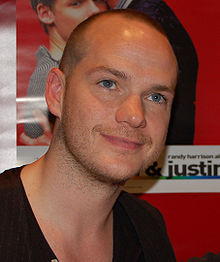Queer

Queer has traditionally meant odd or unusual, though modern use often pertains to LGBT (gay, lesbian, bisexual, transgender, intersex and non-normative heterosexual) people. Its usage is considered controversial and underwent substantial changes over the course of the 20th Century with some LGBT people re-claiming the term as a means of self-empowerment. The term is still considered by some to be offensive and derisive, and by others as a re-appropriated term used to describe a sexual orientation and/or gender identity or gender expression that does not conform to heteronormative society.
Traditional usage
Since its emergence in the English language in the 16th century (related to the German quer, meaning "across, at right angle, diagonally or transverse"), queer has generally meant "strange," "unusual," or "out of alignment." It might refer to something suspicious or "not quite right," or to a person with mild derangement or who exhibits socially inappropriate behavior. The expression "in Queer Street" was used in the UK as of the 1811 edition of Francis Grose's A Classical Dictionary of the Vulgar Tongue for someone in financial trouble.[2]
In the 1904 Sherlock Holmes story The Adventure of the Second Stain, the term is still used in a completely non-sexual context (Inspector Lestrade is threatening a misbehaving constable with "finding himself in Queer Street", i.e., in this context, being severely punished). By the time that story was published, however, the term was already starting to gain its implication of sexual deviance (especially that of homosexual and/or effeminate males), which is already known in the late 19th century; an early recorded usage of the word in this sense was in a letter by John Sholto Douglas, 9th Marquess of Queensberry to his son Lord Alfred Douglas.
Subsequently, for most of the 20th Century, "queer" was frequently used as a derogatory term for effeminate gay males who were believed to engage in receptive or passive anal/oral sex with men, and others exhibiting untraditional gender behavior. Furthermore, masculine males, who performed the role of the 'penetrator' were in some cases considered 'straights'.[3]
As a contemporary antonym of heteronormative

In contemporary usage, some use queer as an inclusive, unifying sociopolitical umbrella term for people who are gay, lesbian, bisexual, pansexual, transgender, transsexual, intersexual, genderqueer, or of any other non-heterosexual sexuality, sexual anatomy, or gender identity. It can also include asexual and autosexual people, as well as gender normative heterosexuals whose sexual orientations or activities place them outside the heterosexual-defined mainstream (e.g. BDSM practitioners, or polyamorous persons). Queer in this sense (depending on how broadly it is defined) is commonly used as a synonym for such terms as LGBT.
One of the first attempts by the LGBT community to re-claim the term "queer" was through an influential though anonymous flier distributed at the New York Gay Pride Parade in June 1990 entitled "Queers Read This".[4]
Because of the context in which it was reclaimed, queer has sociopolitical connotations, and is often preferred by those who are activists, by those who strongly reject traditional gender identities, by those who reject distinct sexual identities such as gay, lesbian, bisexual, and straight, and by those who see themselves as oppressed by the heteronormativity of the larger culture. In this usage it retains the historical connotation of "outside the bounds of normal society" and can be construed as "breaking the rules for sex and gender." It can be preferred because of its ambiguity, which allows "queer"-identifying people to avoid the sometimes strict boundaries that surround other labels. In this context, "queer" is not a synonym for LGBT as it creates a space for "queer" heterosexuals as well as "non-queer" homosexuals.
For some queer-identified people, part of the point of the term 'queer' is that it simultaneously builds up and tears down boundaries of identity. For instance, among genderqueer people, who do not solidly identify with one particular gender, once solid gender roles have been torn down, it becomes difficult to situate sexual identity. For some people, the non-specificity of the term is liberating. Queerness becomes a way to simultaneously make a political move against heteronormativity while simultaneously refusing to engage in traditional essentialist identity politics.
Several television shows, including British and American versions of Queer as Folk, Queer Eye and the cartoon Queer Duck have also used the term in their titles (although Queer as Folk is a reference to the common expression unrelated to homosexuality "There's nowt so queer as folk"). This commonplace usage has, especially in the American colloquial culture, has recently led to the more hip and iconic abbreviation "Q".
The term is sometimes capitalized when referring to an identity or community, rather than merely a sexual fact (cf. the capitalized use of Deaf).
See also
|
|
References
Notes
- ^ Haggerty, George E. (2000, page 691). Gay Histories and Cultures: an Encyclopedia. Taylor & Francis, ISBN 0815318804. Retrieved 2008-06-30.
{{cite book}}: Check date values in:|date=(help) - ^ The Telegraph If one is bankrupt, one is in Queer Street. This originates from the word query which tradesmen and merchants would write against the names of persons who were late in paying. Another theory relates it to Carey Street off Chancery Lane in London which housed the bankruptcy courts.
- ^ A TALE OF TWO SEXUAL REVOLUTIONS; STEPHEN ROBERTSON AUSTRALASIAN JOURNAL OF AMERICAN STUDIES Quote: The most striking addition to the picture offered by D’Emilio and Freedman is a working-class sexual culture in which only those men who took the passive or feminine role were considered ‘queer.’ A man who took the ‘active role,’ who inserted his penis into another man, remained a ‘straight’ man, even when he had an on-going relationship with a man who took the passive role.
- ^ Text of the "Queer Read This" flier. Retrieved 4 Feb 2010.
Bibliography
- Anon. "Queercore". i-D magazine No. 110; the sexuality issue. (1992).
- Crimp, D. AIDS DemoGraphics. (1990).
- Katlin, T. "Slant: Queer Nation". Artforum, November 1990. pp. 21–23.
- Tucker, S. "Gender, Fucking & Utopia". Social text, Vol.9, No.1. (1992).
